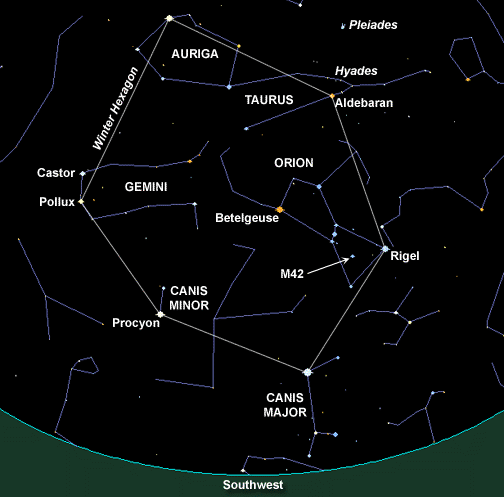Orion looks like an arrow in a box. In the lower right hand of the box is Rigel, the brightest star in the constellation, and the seventh-brightest star visible from Earth. Nobody likes a snitch, but to tell the truth, Rigel cheats: what we see as a single blue-white star is actually three stars. That's not to say Rigel has no bragging rights: its primary star is a blue giant that's more than 100,000 times brighter than our puny yellow Sun! Think of the sales of sunglasses! In the lower left of the box is Saiph, which is about 2,000 light years from Earth. That means that the light hitting your retina tonight left Saiph when Rome was at the height of its empire. In the upper left of the box is red Betelgeuse, which means "shoulder of Orion" (the Arabic astronomers called him Jauza), and is mispronounced by English-speakers (don't get me started) as "beetle juice" — and if you mention that silly movie, this conversation is over! Betelgeuse is the second brightest star in Orion and is the tenth brightest star visible from Earth. It's a red giant, very near the end of its career as a star. It's so bloated that if it were where our sun is, its outer rim would reach almost to Jupiter. People in ages hence will one night see it supernova. In the upper right of the box is Bellatrix, who has no opinion about Hogwarts. And that's just the box! The three bright stars in the middle, which form Orion's belt, are sisters to our own Sun. They were made about the same time as our own star and are what the Sun would look like from any planets that might be circling them. This doesn't even begin to exhaust the interesting things about Orion, but if I don't hit a line break for this paragraph, I'm going to get in trouble with the w3 Consortium.
Orion is a good home base in the winter, not only because it's such an arresting centerpiece of the winter sky, but because Rigel is one-sixth of a famous asterism known as The Winter Hexagon. The stars in this formation are some of the brightest and best known of stars visible from Earth, including, though it's not named in this picture, Sirius, which is the brightest star in the box (it's the star on the bottom of the hexagram, in Canis Major; it's the eye of one of Orion's hunting dogs, also known as the Dog Star and gave its name to the Dog Days of Summer). The other star left unnamed in the diagram is Capella, at the opposite end of the hexagram, in Auriga, which is number 6 on the bright star pop charts.

From any one of them, it's a matter of branching out, just like you did with the Big Dipper. So, as Peter Pan would say, "Second star to the right, and straight on till morning!" From this point, you're ready to go deeper into the night, and on to the Purple Series of this site. Safe travels!
Coming Soon – Get Darker